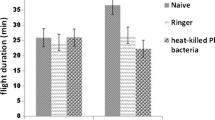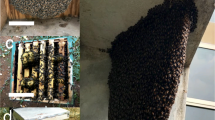Abstract
Accurate thermoregulation in honey bees is crucial for colony survival. Multiple factors influence how colonies manage in-hive temperature, including genetic diversity. We explored the influence of genetic diversity on thermoregulatory behavior under three conditions: natural foraging, supplemental feeding, and exposure to the fungal pathogen shown to induce a social fever in honey bees. Our data suggest that (1) the degree of genetic diversity expected under normal conditions is not predictive of thermoregulatory stability, (2) the social fever response of honey bees is not a simple stimulus–response mechanism but appears to be influenced by ambient temperature conditions, and (3) a temperature-based circadian rhythm emerges under high nectar flow conditions. Taken together, these data suggest that a richer, context-dependent thermoregulatory system exists in honey bees than previously understood.


Similar content being viewed by others
References
Aronstein KA, Murray KD (2010) Chalkbrood disease in honey bees. J Invertebr Pathol 103:S20–S29
Bailey L (1981) Honey bee pathology. Academic, London
Bailey L, Ball BV (1991) Honey bee pathology. Academic, London
Basile R (2009) Thermoregulation and resource management in the honeybee (Apis mellifera). Ph.D. Dissertation. University of Wurzburg, Germany
Basile R, Pirk CWW, Tautz J (2008) Trophallactic activities in the honeybee brood nest–heaters get supplied with high performance fuel. Zoology 111:433–441
Chorbinski P, Rypula K (2003) Studies on the morphology of strains Ascosphaera apis isolated from chalkbrood disease of the honey bees. Vet Med 6:1–12
Delaney DA, Keller JJ, Caren JR, Tarpy DR (2011) The physical, insemination, and reproductive quality of honey bee queens (Apis mellifera). Apidologie 42:1–13
Eban-Rothschild A, Bloch G (2012) Circadian rhythms and sleep in honey bees. In: Galizia GC, Eisenhardt D, Giurfa M (eds). Honeybee neurobiology and behavior: a tribute to Randolf Menzel. Springer, Dordrecht, The Netherlands, pp 31–46
Edery I (2000) Circadian rhythms in a nutshell. Physiol Genomics 3:59–74
Evans JD, Spivak M (2010) Socialized medicine: individual and communal disease barriers in honey bees. J Invertebr Pathol 103:S62–S72
Flores JM, Ruiz JA, Ruz JM, Puerta F, Bustos M, Padilla F, Campano F (1996) Effect of temperature and humidity of sealed brood on chalkbrood development under controlled conditions. Apidologie 27:185–192
Flores JM, Gutierrez I, Puerta F (2004) A comparison of methods to experimentally induce chalk brood disease in honey bees. Span J Agric Res 2:79–83
Frisch B, Aschoff J (1987) Circadian rhythms in honeybees: entrainment by feeding cycles. Physiol Entomol 12:41–49
Fuchs S, Moritz RFA (1998) Evolution of extreme polyandry in the honeybee Apis mellifera L. Behav Ecol Sociobiol 9:269–275
Fuller P, Lu J, Saper C (2008) Differential rescue of light- and food- entrainable circadian rhythms. Science 320:1074–1077
Gates B (1914) The temperature of the bee colony. Bull US Dep Agric 96:1–29
Graham S, Myerscough MR, Jones JC, Oldroyd BP (2006) Modelling the role of intracolonial genetic diversity on regulation of brood temperature in honey bee (Apis mellifera L.) colonies. Insect Soc 53:226–232
Groh C, Tautz J, Rossler W (2004) Synaptic organization in the adult honey bee brain is influenced by brood-temperature control during pupal development. Proc Natl Acad Sci 101:4268–4273
Hou C, Kaspari M, Vander Zanden H, Gillooly J (2010) Energetic basis of colonial living in social insects. Biol Lett 107:3634–3638
Humphrey JAC, Dykes ES (2008) Thermal energy conduction in a honey bee comb due to cell-heating bees. J Theor Biol 250:194–208
Jones J, Oldroyd B (2007) Nest thermoregulation in social insects. Adv Insect Physiol 33:153–191
Jones J, Myerscough M, Graham S, Oldroyd B (2004) Honey bee nest thermoregulation: diversity promotes stability. Science 305:402–404
Klein BA, Olzsowy KM, Klein A, Saunders KM, Seeley TD (2008) Caste-dependent sleep of worker honey bees. J Exp Biol 211:3028–3040
Kleinhenz M, Bujok B, Fuchs S, Tautz J (2003) Hot bees in empty broodnest cells: heating from within. J Exp Biol 206(23):4217–4231
Kraus FB, Neumann P, van Praagh J, Moritz RFA (2004) Sperm limitation and the evolution of polyandry in the honeybee (Apis mellifera L.). Behav Ecol Sociobiol 55:494–501
Kronenberg F, Heller C (1982) Colonial thermoregulation in honey bees (Apis mellifera). J Comp Physiol B 148:65–76
Mattila H, Seeley T (2007) Genetic diversity in honey bee colonies enhances productivity. Science 317:362–364
Moore D (2001) Honey bee circadian clocks: behavioral control from individual workers to whole-colony rhythms. J Insect Physiol 8:843–857
Moore D, Rankin MA (1993) Light and temperature entrainment of a locomotor rhythm in honeybees. Physiol Entomol 18:271–278
Nielsen R, Tarpy DR, Reeve HK (2003) Estimating effective paternity number in social insects and the effective number of alleles in a population. Mol Ecol 12:3157–3164
Oldroyd BP, Fewell JH (2007) Genetic diversity promotes homeostasis in insect colonies. Trends Ecol Evol 22:408–413
Page R (1980) The evolution of multiple mating behavior by honey bee queens (Apis Mellifera L.). Genetics 96:263–273
Page RE, Robinson GE, Calderone NE, Rothenbuhler WC (1989) Genetic structure, division of labor, and the evolution of insect societies. In: Breed MD, Page RE (eds) The genetics of social evolution. Westview, Boulder, pp 15–30
Page RE, Robinson GE, Fondrk MK, Nasr ME (1995) Effects of worker genotypic diversity on honey bee colony development and behavior (Apis mellifera). Behav Ecol Sociobiol 36:387–396
Palmer K, Oldroyd B (2000) Evolution of multiple mating in the genus Apis. Apidologie 31:235–248
Pratt SC (2004) Collective control of the timing and type of comb construction by honey bees (Apis mellifera). Apidologie 35:193–205
Robinson G, Page R (1989) Genetic basis for division of labour in an insect society. In: The genetics of social evolution. Westview Press, Boulder, pp 61–88
Rueppell O, Johnson N, Rychtar J (2008) Variance-based selection may explain general mating patterns in social insects. Biol Lett 4:270–273
Seeley TD (1985) Honeybee ecology: a study of adaptation in social life. Princeton Univ. Press, Princeton
Seeley TD (1995) The wisdom of the hive. Harvard University Press, Cambridge
Seeley TD, Tarpy DR (2007) Queen promiscuity lowers disease within honeybee colonies. Proc R Soc 274:67–72
Sherman PW, Seeley TD, Reeve HK (1998) Parasites, pathogens, and polyandry in social hymenoptera. Am Nat 131:602–610
Siegel AJ, Hui J, Johnson RN, Starks PT (2005) Mobile insulator units: honey bee workers as living insulation. Insect Soc 52:242–246
Smith CR, Toth AL, Suarez AV, Robinson GE (2008) Genetic and genomic analyses of the division of labour in insect societies. Nat Rev Genet 9:735–748
Solignac M, Vautrin D, Loiseau A, Mougel F, Baudry E, Estoup A, Garnery L, Haberl M, Cornuet J-M (2003) Five hundred and fifty microsatellite markers for the study of the honeybee (Apis mellifera L.) genome. Molec Ecol Notes 3:307–311
Southwick E (1982) Metabolic energy of intact honey bee colonies. Comp Biochem Physiol 71:277–281
Southwick EE (1987) Cooperative metabolism in honey bees: an alternative to antifreeze and hibernation. J Therm Biol 12(2):155–158
Southwick EE, Heldmaier G (1987) Temperature control in honey bee colonies, precise social cooperation permits adaptation to temperate climates. Bioscience 37:395–399
Stabentheiner A, Kovac H, Brodschneider R (2010) Honeybee colony thermoregulation–regulatory mechanisms and contribution of individuals in dependence on age, location and thermal stress. PLoS ONE 5(1). doi:10.1371/journal.pone.0008967
Starks PT, Blackie CA, Seeley TD (2000) Fever in honeybee colonies. Naturwissenschaften 87:229–231
Starks PT, Johnson RN, Siegel AJ, Decelle MM (2005) Heat-shielding: a task for youngsters. Behav Ecol 16:128–132
Swanson JAI, Torto B, Kells SA, Mesce KA, Tumlinson JH, Spivak M (2009) Odorants that induce hygienic behavior in honeybees: identification of volatile compounds in chalkbrood-infected honeybee larvae. J Chem Ecol 35:1108–1116
Tarpy DR (2003) Genetic diversity within honeybee colonies prevents severe infections and promotes colony growth. Proc R Soc B 270:99–103
Tarpy DR, Nielsen D (2002) Sampling error, effective paternity, and estimating the genetic structure of honey bee colonies (Hymenoptera: Apidae). Ann Entomol Soc Am 95:513–528
Tarpy DR, Nielsen R, Nielsen DI (2004) A scientific note on the revised estimates of effective paternity frequency in Apis. Insect Soc 51:203–204
Tarpy DR, Caren J, Delaney D, Sammataro D, Finley J, Loper G et al (2010) Mating frequencies of Africanized honey bees in the South Western USA. J Apic Res 49:302–310
Tarpy DR, vanEngelsdorp D, Pettis JS (2013) Genetic diversity affects colony survivorship in commercial honey bee colonies. Naturwissenschaften 100:723–728
Tautz J, Maier S, Rossler W, Brockmann A (2003) Behavioral performance in adult honey bees is influenced by the temperature experienced during their pupal development. Proc Natl Acad Sci 100:7343–7347
Vojvodic S, Jensen AB, James RR, Boomsma JJ, Eilenberg J (2011) Temperature dependent virulence of obligate and facultative fungal pathogens of honeybee brood. Vet Microbiol 149:200–205
Walsh PS, Metzger DA, Higuchi R (1991) Chelex(r) 100 as a medium for simple extraction of DNA for PCR-based typing from forensic material. BioTech 10:506–513
Wang JL (2004) Sibship reconstruction from genetic data with typing errors. Genetics 166:1963–1979
Wilson-Rich N, Spivak M, Fefferman NH, Starks PT (2009) Genetic, individual, and group facilitation of disease resistance in insect societies. Annu Rev Entomol 54:405–423
Wilson-Rich N, Tarpy DR, Starks PT (2012) Within- and across-colony effects of hyperpolyandry on immune function and body condition in honey bees (Apis mellifera). J Insect Physiol 58:402–407
Acknowledgments
We would like to thank Joel Caren for assisting with the genotyping of the colonies. This study was supported by the National Research Initiative of the USDA Cooperative State Research, Education and Extension Service, grant number 2007-02281, and a National Science Foundation REU site award to Tufts University (DBI-0649190).
Author information
Authors and Affiliations
Corresponding author
Rights and permissions
About this article
Cite this article
Simone-Finstrom, M., Foo, B., Tarpy, D.R. et al. Impact of Food Availability, Pathogen Exposure, and Genetic Diversity on Thermoregulation in Honey Bees (Apis mellifera). J Insect Behav 27, 527–539 (2014). https://doi.org/10.1007/s10905-014-9447-3
Revised:
Accepted:
Published:
Issue Date:
DOI: https://doi.org/10.1007/s10905-014-9447-3




